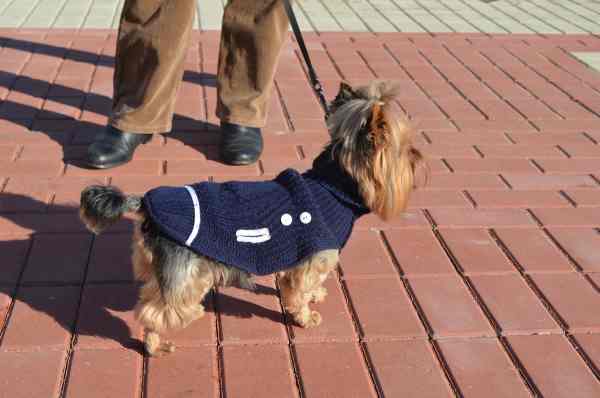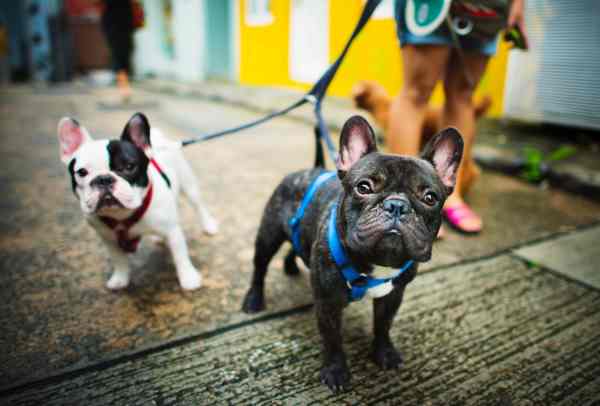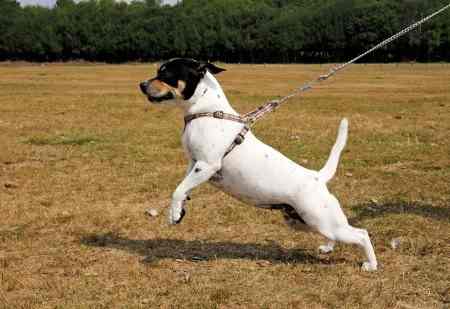Leash Training a Puppy and Older Dog
Leash Training a Puppy by Lauretta Williams |Last Updated 02-03-2020
Who’s walking who??
That’s the most common confusion that arises on the beginner trainer’s mind.
But don’t worry! That’s not even a problem. It’s completely natural!
Wanna know why?

Suppose you’ve just adopted a cute puppy. Puppies get excited when you walk them to the park. Basically, puppies are very keen to explore.
And as a pet owner, you should increase her curiosity to explore. And it will be possible only by loose leash training.
But this training isn’t as easy as that innocent phrase! To be honest, it may be one of the harder tricks for the pet owners.
But, you can turn this pain into pleasure by working smartly. You know, working hard doesn’t bring happiness always, you need to work intelligently.
That’s why I’m presenting this blog only for those small dog pet owners who love to “think outside of the box”!
Okay, let’s get started!
Leash Training a Puppy Choose Your Gear
Choosing the right gear is the very first thing to do when training. So, what kind of equipment do you need? For the basic loose leash training, you need to collect the following equipment.
- Collar (harness preferred)
- Leash
- Treats
Leash Training a Puppy: Collars
Several types of dog collars are available.
Standard collar
This is the most commonly used collar. I don’t know why pet owners love it, but it is usually one of the first items a new puppy owner will buy for their dog. Collars are suitable for holding identification tags but shouldn’t be used for leash training, especially with small dogs.
Measure your dog’s neck with a tape measure. Look at the sizes which should be on the product’s package. Purchase the one that is most appropriate for your dog. You may need to purchase new ones as the dog grows.
Martingale collar
This one is my personal favorite. It’s a great collar for the dogs not accustomed to walking on a leash. Martingale collars have a double loop. Whenever your pet pulls the leash, the loop will tighten.
But don’t worry. It won’t choke. It will just tighten the loop a bit. It makes the pet uncomfortable. That’s it.
Back Harness
Standard collars are the worst, especially for the smaller breeds. Puppies that pull on their leash are likely to choke easily with a standard type of collar.
A better alternative is the back harness and a must if you have a brachycephalic breed of dog. Additionally, you will get more control over the pet if you use a back harness.
Head Halter
It’s a rare collar. This collar is used to focus on the owner instead of following the nose. Just like the back harness, it offers more control to the owner.
Leash Training a Puppy: The Leash
From my previous experience, I’ve seen that people pay the least attention to the leash. They just purchase a standard lead from the local market. But, you should not do that.
There are several things that you should keep in mind before buying the leash.
- Make sure that the leash is sturdy enough
- Use a flexible leash
- Match the size of the dog to the width and weight of the leash.
Let’s’ have a look at different types of leashes.
Standard Leash
It is the most common and traditional type of leash. Leashes can be a flat band or a styled rope leash. They come in a variety of materials, colors, lengths, and widths.
ou attach one end to your puppy’s collar or harness, and the other end remains in your hand. Some leashes now come with dual handles, one at the end and the other about a foot or two from the clip that connects to the dog’s harness.
These may be impractical for training a small dog but might be good if you plan to walk on busy city streets.
The standard leash is available in different styles, lengths, and materials. Though it may seem old-fashioned, it’s better to use it in the beginning part of your dog’s training.
A four to six-foot lead is an excellent choice for most dogs. For small dogs, look for a 3/8 to ½ inch width.
Retractable Leash
This type of leash is probably the most digitized lead you will use to control your puppy. The retractable leash consists of a long belt or cord and a handle that fits comfortably in your hand.
As the name implies, the belt is coiled inside the handle and can be released to the desired length and then locked in place.
Before purchasing this type of leash, use a standard leash for training purposes.
Leash Training a Puppy: Don't Forget Treats
You need to offer treats to your dog during this loose leash training period. That’s how she will be energized and become interested in the training.
Find treats that your dog loves and break them into tiny pieces as you walk. Since you are training to walk on a leash, a small pouch or container to keep the treats handy works very well.
 Use a back harness when leash training a puppy to prevent injury to the neck and throat
Use a back harness when leash training a puppy to prevent injury to the neck and throatLoose Leash Training a Puppy
Hope that you’ve already collected these tools. Let’s start the journey!
Training your dog for walking on a leash isn’t tricky, but you will need patience as your puppy learns to walk.
Most importantly, never skip any step or move to the next level until your pooch mastered the previous step.
Commands to Use When Leash Training a Puppy
Your dog is now ready for obeying the command. At the beginner level, you may start with the following three commands – plus one more
- Let’s go
- Stop
- Walk
- Look at me
Use the “Let’s go” command to initiate the training. The “Stop” one can use when you need to stop as in traffic on the road and “Walk” to continue the walk.
The “look at me” is a trick that can be taught separately. It is a way to make eye contact before using the other commands.
Look at Me
Start by looking at your dog. As soon as she looks back at you, praise with “yes” and give her a treat. Repeat a few more times, then combine the words, “yes, look at me,” and treat.
Soon, you should be able to give the command, Look at me, and she will look at you.
Continue to treat until she has the command down correctly. You may want to practice this command at home before attempting leash training.
Let’s Go – Stop -Walk
Once you have your dog’s attention and eye contact, say the words, Let’s go and take a step with your right foot. Continue to walk about 6 steps. Then stop, and say stop. Treat if she stops.
Wait to get her attention again, and then say walk and begin to walk yourself. It is difficult to give a treat while you and she are walking so the treats will be reserved for the stops.
But, you can reward her for walking nicely on a leash by the amount of praise you give her as you walk. Enthusiastic Yes, Good Dog, Good Girl, etc. may be just as rewarding for some dogs as food treats.
As you can see, this process is slow going for some dogs. Pressuring her to do your commands will be counterproductive. Remember she is a puppy and will tire out quickly.
If you see that she is losing interest and is acting tired, stop and continue the training at another time.
Problems You May Encounter When Leash Training a Puppy
Eliminate the self-rewarding behaviors
 Pulling on the leash is one problem you may encounter when leash training a puppy.
Pulling on the leash is one problem you may encounter when leash training a puppy.This really isn’t a step but rather a phenomenon that is seen frequently by trainers and owners of older dogs that have not been adequately trained.
On the very first day of your dog’s training, you may notice that she starts pulling the leash. I was wholly astonished on my first day of practice wondering why my dog would pull so hard on the leash that she began gasping for air.
You know, pulling the leash isn’t a natural behavior of your dog. She wasn’t born with that behavior. So, why is she doing that?
The main reason behind this behavior is she is being reinforced or rewarded for what she is doing. Suppose you are on your way to the park to play a fetching game.
She has learned that if she pulls her lead, she will get to the park faster because you will naturally walk faster. She is anticipating the excitement of playing her favorite game of fetch.
Unfortunately, most dog owners don’t even know that their dog is rewarding itself by pulling the leash.
There is nothing wrong about it. But the problem occurs when it becomes habitual. You may notice that the dog will pull you when it’s time to play.
Just think about it from the dog’s perspective. Why is she pulling? Why doesn’t she walk slow and steady while heading to the park?
The faster you reach the park, the faster she can play.
So, how to solve this problem?
Actually, it’s pretty easy for puppies to break the habit. But it requires more training for older dogs.
All you have to do is practicing a few simple exercises. At first, try to explore how often she pulls. If she pulls very frequently, it has already become a bad habit. It requires more practice.
Whenever your dog pulls the leash, stop in place. Do not begin to walk again until she calms down a bit and stops pulling.
Another option is to turn around and start walking in the opposite direction. This maneuver is likely to get her attention and perhaps confuse her.
You may need to repeat your stop or turn around many times over many walks.
When your dog is walking nicely and not pulling, reward her with a treat. If she starts to pull, repeat the process.
Eventually, she will get the idea that when she walks nicely, she gets a treat. When she pulls, she gets nothing, and the walk stops.
It will take time, dedication and consistency on your part, but in the end, it will pay off. You will enjoy the walk and so will your dog.
The worst-case scenario for training your dog to walk on a leash would be if she were to become free from your hand and run off. This often happens when the dog owner gets distracted.
You meet up with a friend and begin to talk and not pay attention to the dog. Within seconds, your dog may be gone.
Tragedies like this do happen. However, you may contact the lost pet finder for assistance. They can help you find your dog.
Leash Training a Puppy: The Reluctant Canine
Help, my dog won’t walk on a leash!
On the opposite side of the spectrum is the puppy who digs in and refuses to walk at all. This can be equally frustrating, but there are ways to convince her that walking on a leash is not all bad.
For the dog who won’t walk, the trick is to go very slow as not to cause any fear or anxiety. Start inside and attach the leash to her harness.
Let her walk around to get the feel of it. Praise or offer a treat periodically. You can do this for a very short period several times a day.
Next, it’s time to take the training outdoors in an enclosed area so there is no fear the dog will run away. Let your dog drag the leash around just as you have done indoors.
Be sure there are no obstacles in the way for her to get tangled. Praise and reward.
Now it is time to take it to the next level. You can do this sitting or standing. Have treats in one hand and the leash in the other hand. Gently put a small amount of pressure on the leash but not enough to hurt or startle her.
Treat.
Add a bit more pressure and treat.
The whole idea behind this method is that she is beginning to understand that a bit of pressure/pull on the leash brings good things (treats).
Finally, stand up, hold the leash in one hand and a treat that is visible to your dog in the other hand. Put more pressure on the leash as you hold the treat at her nose level.
If she takes a few steps, praise and give her the treat. Continue in this manner. If you are using a 6-foot leash, move to the end, have the treat ready and call to her.
Treat.
Once you feel as though she is ready, go back to the steps mentioned above and start the commands, Let's Go, Stop, and Walk. Don’t rush this process.
If you sense your dog is getting tired or anxious, stop and pick up where you left off at another time.
Leash Training a Puppy: Bottom Line
The most effective way to strengthen the bond between you and your dog is frequent walking. It helps them manage the stress level and also keeps them disciplined and healthy. And, there are health benefits to you too.
To achieve a smoother walking experience, you have to train your dog to walk on the leash properly. And during the training period, always remember the main mantra –
“Patience is the key to success!”
Lauretta Williams, the author of Leash Training a Puppy is a web-addicted blogger. She loves spending her time listening to music, playing with her dog and writing blogs from her computer. She also loves to travel the world. She works with PawMaw. PawMaw can help you find your lost pet quickly.
Recommended for Leash Training a Puppy Readers
Teaching the 5 Basic Dog Commands
Training Small Dogs, the Most Efficient Way
About Janice (author and voice behind this site)
Having lived with dogs and cats most of her life, Janice served as a veterinary technician for ten years in Maryland and twelve years as a Shih Tzu dog breeder in Ohio.
Her education includes undergraduate degrees in Psychology with a minor in biology, Early Childhood Education, and Nursing, and a master's in Mental Health Counseling.
She is a lifelong learner, a dog lover, and passionate about the welfare of animals. Her favorite breed for over 50 years has been the Shih Tzu, but she has also lived with poodles, Maltese, Yorkshire Terriers, beagles, English bulldogs, carin terriers, and a Cocker Spaniel.
When not writing, reading, and researching dog-related topics, she likes to spend time with her eight Shih Tzu dogs, husband, and family, as well as knitting and crocheting. She is also the voice behind Miracle Shih Tzu and Smart-Knit-Crocheting
Does This Article Deserve Your Thumbs Up?
We always appreciate your support and encouragement. Your thumbs up means so much to us. Please like this article.
If you find this page or any page on Small Dog Place Helpful, or useful in anyway, I'd love it if you would click the small heart found on the bottom right of each page.
You can also share or bookmark this page -- just click on the:

Free Monthly Newsletter
Sign Up for Our Free Newsletter and get our Free Gift to You.
my E-book, The Top 10 Mistakes People Make When Choosing a Dog (and how to avoid them)

